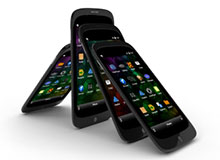Smartphone maker HTC has repeatedly cut its earnings and revenue outlook, and is reportedly shuttering its South Korea office. Nokia is struggling with a lukewarm response to its Lumia Windows Phone devices and challenges in markets such as China. And Research in Motion has lost market share and delayed its next generation of smartphones until 2013.
The troubles facing these technology manufacturers are reflective of what is shaping up to be a shakeout in the evolving smartphone market, which is increasingly dominated by just two companies, Samsung and Apple.
Hardware makers are likely to take the biggest hit in such a market rejiggering because most of the competition in the industry boils down to two competing operating platforms and application ecosystems: Google’s Android and Apple’s iOS. Apple’s operating system runs on the firm’s own devices, while the Android market features cutthroat competition and a range of devices by Samsung, HTC, LG, Motorola Mobility (now owned by Google) and Chinese players like ZTE and Huawei.
“These shakeouts happen in most industries, across many categories,” says David Hsu, a management professor at Wharton. “The only question is how long it takes before the shakeout occurs.” Hsu notes that the technology industry has seen these shakeouts repeatedly. Once hardware becomes a commodity, consolidation follows. For instance, the PC industry has seen the hard drive market whittled down to two primary players: Western Digital and Seagate. PC makers have also been trimmed to a handful. In software and the Internet, duopolies have emerged as a natural course of business: Consider Google, which dominates the search market, and Microsoft’s Bing, behind it. Computing operating systems boil down to Microsoft’s Windows and Apple’s Mac OS X, with a few users using open source software like Ubuntu and other flavors of Linux.
As recently as two years ago, the smartphone tide provided a boost to many hardware manufacturers. The expectation was that most mobile phone users would eventually migrate to smartphones, a prediction that is playing out today: According to comScore, 110 million Americans owned a smartphone as of April, up 44% from a year ago.
Meanwhile, 61.5% of new smartphone buyers are picking various Android devices, and 25.2% are choosing Apple’s iPhone, comScore reported. With 86.7% of the market covered by Android and iOS, companies like Nokia, which uses Windows Phone as the operating system for its new devices, and Research in Motion, which uses a proprietary operating system, are left to fight for the scraps.
And those firms are rapidly losing ground. According to a July 26 report from research firm IDC, Samsung and Apple have doubled their combined market share over the last two years. (This week, the two dominant players are meeting in federal district court, with Apple accusing Samsung of patent violations.)
Software Rules, Hardware Doesn’t
According to Wharton management professor Saikat Chaudhuri, hardware companies often end up at the bottom of the food chain in a sector like smartphones, where software and an ecosystem of developers and applications are ways that different players set themselves apart. “If there’s one thing we’ve learned, it is that the ecosystem is key: Are there good apps there?” says Kendall Whitehouse, director of new media at Wharton. “Anyone just focused on the hardware end of it will find it challenging to succeed.”
“The smartphone market is seeing a standards battle, and hardware is at the bottom of the pecking order,” notes Chaudhuri. Indeed, Nokia is switching from its former Symbian OS to throw in with Microsoft’s Windows Phone platform and has had respectable, but not overwhelming, sales. Research in Motion is hinging future success on its oft-delayed BlackBerry 10 operating system, which won’t arrive until 2013.
RIM and Nokia are both hoping to emerge as the strong No. 3 mobile platform to challenge Apple and Android.
Without software differentiation or cutting-edge hardware designs, device manufacturers must compete on scale and price. That reality is playing out in the Android marketplace. HTC, once a darling of Android device makers, has cut its revenue outlook repeatedly in recent months. “The smartphone market is seeing the normal course of evolution,” says Chaudhuri. “In the beginning, there were a lot of different designs and touch-screen innovation. There were huge improvements. Now, improvements are incremental and not so radical that [consumers] need to switch smartphones every six months.”
Even Apple isn’t immune. Apple’s fiscal third quarter results fell short of Wall Street estimates on July 24 largely because consumers are opting to hold out for the next-generation iPhone rather than buy the latest model, the 4S, analysts note. “Our weekly iPhone sales continue to be impacted by rumors and speculation regarding new products,” said Apple chief financial officer Peter Oppenheimer on the company’s earnings conference call.
Apple and Samsung’s positions at the top aren’t solidified, Chaudhuri states, because the market “hasn’t reached a dominant hardware design.” Many consumers still want a smartphone with a physical keyboard rather than a touch screen. And the market for smartphones also continues to coalesce with the tablet sector. “The dominant hardware design is not quite settled due to the physical limitations of creating one device that can do everything.”
But even if a strong No. 3 platform emerges, Hsu wonders: What’s really in it for the hardware companies? The answer to that question, he adds, depends on business model innovation and whether hardware-centric smartphone makers like RIM, Nokia and HTC can garner ad revenue or charge software firms for building applications to go with their devices.
Caught in the Crossfire
While Apple and Samsung fight for smartphone dominance, the casualties in the middle are starting to pile up.
On June 6, HTC, which once was leading the Android charge, warned that its second quarter results would fall short of previous projections. Analysts on a conference call with HTC CFO Chialin Chang were testy. One analyst noted how HTC “is invisible” in London as Samsung was everywhere touting its Samsung Galaxy S3. The analyst said the “Samsung marketing machine is huge and a very tough competitor.”
In response to those concerns, Chang noted that “based on the scale we have, we’re obviously going to have to play smart.”
Macquarie analyst Daniel Chang said in a research note that HTC is sandwiched between Apple and Samsung. He added that Apple is expected to launch its new iPhone in the fall. “The launch would not only eat up market share from all Android players including HTC, but also pressure Samsung to adopt a more aggressive pricing strategy on Galaxy S3 to protect its market share,” he wrote. “HTC could face a direct impact given its overlapping customers.”
Hsu agrees. “Android is pretty standard, so it’s all about price competition,” he says.
The story isn’t much better for Nokia. On July 19, it reported a second quarter net loss of $404.9 million on revenue of $9.67 billion based on current euro to U.S. dollar exchange rates. Nokia CEO Stephen Elop said the company’s sales of its Lumia Windows Phone devices weren’t brisk enough to offset declining sales in China and other regions. Elop noted that Nokia sold four million Lumia devices in the second quarter. “We are committed to Windows Phone as our primary smartphone strategy,” Elop stated on a July 19 conference call. “We have learned that it takes a tremendous amount of work to break through as the third ecosystem.” Elop added that he is betting that demand for Windows Phone will pick up once Microsoft releases its Windows 8 operating system, which has a similar user interface.
But credit rating service Moody’s downgraded Nokia’s rating on worries that the company may burn through its net cash balance of 4.2 billion euro too quickly. Nokia said in a statement it was “disappointed with the decision,” but is positioning the company for future growth.
Research in Motion is also struggling. On June 28, RIM reported a fiscal first quarter loss of $518 million on revenue of $2.81 billion and delayed its BlackBerry 10 mobile operating system. Wall Street analysts now expect RIM to lose money through February. RIM CEO Thorsten Heins said on a conference call that he wasn’t happy with the company’s results. “Our first-quarter results reflect the platform and product transition we are going through, ongoing market challenges and the competitive dynamics we are seeing across many of our markets,” noted Heins. “We are not standing still. We are convinced that BlackBerry can deliver value as an integrated hardware, software and services offering.”
RIM and Nokia may only have a few chances left to deliver a strong software/hardware package to compete with Samsung and Apple, according to Chaudhuri. “At some point, Nokia and RIM will have to dump their operating systems and move to something that becomes the standard.”
Why are Nokia and RIM clinging to the idea that they can compete in hardware and software? Both Elop and Heins have said that they can deliver value and preserve profit margins by being unique. Elop has said that a move to Android would put the company in cutthroat price competition with HTC, Samsung and a bevy of Chinese competitors, as well as make it harder to deliver value.
“Nobody wants to be in a duopoly,” Chaudhuri points out. “It’s not too late for a No. 3 platform, but it’s getting harder.” However, both Nokia and RIM have a tough challenge ahead. “The barrier to entry for a new mobile OS is very high,” notes Whitehouse. “And iOS and Android are continuing to innovate.”
Smartphone Growth Slowing?
The squeeze among smartphone manufacturers could become worse should device sales begin to slow down. According to IDC, the global smartphone market shipped 153.9 million smartphones in the second quarter, up 42.1% from a year ago. But that growth rate was the slowest since the fourth quarter of 2009. IDC analyst Ramon Llamas said in a statement that economic woes in Europe and select emerging markets are crimping smartphone sales.
Meanwhile, smartphone component makers Texas Instruments and Qualcomm have both cut their outlooks for future quarters, indicating that demand is weaker than expected. IDC reported that Samsung was the leading smartphone manufacturer globally, with 32.6% market share. Apple followed with 16.9% market share in the second quarter. Nokia’s market share was 6.6%, down 38.9% from a year ago. HTC’s share was 5.7%, down 24.1% from a year ago. Meanwhile, Chinese newcomer ZTE had second quarter market share of 5.2%, up 300% from a year ago.
Wharton legal studies and business ethics professor Andrea Matwyshyn predicts that smartphone growth rates will continue to slow as the rate of improvements wanes. “The categories are relatively firm for what a phone can do,” says Matwyshyn. “Smartphones aren’t as novel and cool as they once were. There’s smartphone fatigue.”
Part of that fatigue may be simple evolution, but other aspects may be cultural, she adds. “Smartphones are a way to psychologically tether people to work,” says Matwyshyn. As a result, smartphones may not look as appealing as they once were to those who haven’t bought one yet.
But that doesn’t necessarily mean that growth rates will drop dramatically — there are still a number of emerging markets that smartphone makers have yet to fully exploit. In addition, it’s always possible that some new application, operating system or hardware design will win over consumers the way the iPhone and Android have. “It’s an open question how long this generation of smartphone leaders lasts before new ones emerge,” Hsu says.



